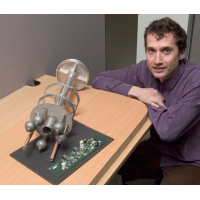Detecting explosives

Lancaster University is leading a consortium to build a prototype scanner to detect hidden explosives.
The threat of global terrorism means there is a demand for increasingly fast and reliable methods of screening goods in transit for hidden explosives.
Current systems rely on x-ray techniques, which are time consuming as they depend on trained staff scanning the x-ray images and searching for suspicious objects.
But a Lancaster-led team of international researchers from Lancaster, Manchester and Liverpool Universities is now developing a prototype, which will combine both visual scanning and nuclear technology capable of identifying explosive material.
The consortium – known as Distinguish – brings together nuclear engineers, nuclear physicists and tomographical imaging experts and has been funded by a £400k Engineering and Physical Sciences Research Council grant.
Collaborators in the project include BAE SYSTEMS, NIS Ltd, Manchester Airport, John Caunt Scientific and the Police Scientific Development Branch.
Malcolm Joyce of Lancaster University’s Engineering Department, who is heading the consortium, said technological developments meant that existing scanning techniques could be improved upon.
“False positives – when an object appears to be an explosive but subsequently proves not to be – are very expensive and time consuming but on the other hand one mistake could result in another Lockerbie.
“Our method will identify materials that are explosive as well as giving us a detailed image. ”
He said the new scanning technology could be used to scan anything from single suitcases to large transporter containers.
Using nuclear physics research developed at the University of Liverpool suspect items will be exposed to a beam of pulsed neutrons. This will cause the item to emit gamma radiation, which will reveal whether any explosives are inside. Manchester University tomographic experts can then convert this radiation data into an image. Lancaster Engineers will be responsible for putting the proto type together.